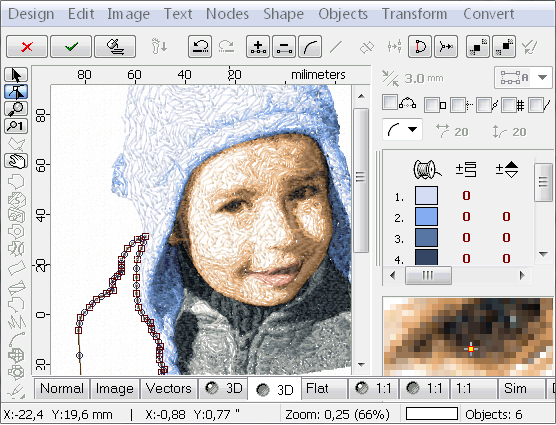Comprehensive Digitizing for Embroidery: From Layout to Stitch
Comprehensive Digitizing for Embroidery: From Layout to Stitch
Blog Article
Grasping the Embroidery Digitizing Refine: Your Ultimate Overview
Needlework digitizing is a meticulous craft that requires accuracy and know-how to translate complex styles right into electronic styles for machine embroidery. As craftsmens get started on this journey to grasp the embroidery digitizing procedure, a comprehensive understanding of the basics sets the structure for excellence.

Recognizing Needlework Digitizing Essentials
Needlework digitizing basics develop the foundation whereupon intricate styles are converted into machine-readable formats for specific sewing. This initial action in the embroidery digitizing process is critical for guaranteeing that the last stitched item is a loyal depiction of the initial design. Comprehending needlework digitizing basics includes comprehending essential ideas such as stitch types, sew direction, thickness, rug, and draw settlement.
Sew kinds play a vital role in identifying the visual and textural outcome of the stitched design. By choosing the proper stitch kind, whether it be satin, fill, or running stitch, digitizers can accomplish the desired effect and boost the overall high quality of the needlework. In addition, sew direction affects the flow and measurement of the style, while density identifies the spacing and protection of the stitches.
In addition, padding sewing supplies security to the style by safeguarding the textile and protecting against distortion during the embroidery process. Pull settlement is another crucial consideration to combat the all-natural propensity of fabric to contract when stitched. Grasping these needlework digitizing essentials is fundamental for producing professional-quality stitched products.
Selecting the Right Digitizing Software Program
Picking the proper digitizing software program is a crucial decision that dramatically influences the effectiveness and quality of the embroidery digitizing process. Digitizing for Embroidery. When choosing the appropriate digitizing software application, it is vital to think about elements such as the intricacy of designs you plan to develop, the user-friendliness of the software application, the degree of consumer support supplied, and the compatibility with your embroidery machine
There are numerous digitizing software application choices available in the marketplace, varying from standard programs for beginners to innovative software application for specialist digitizers. Some prominent options consist of Wilcom EmbroideryStudio, Hatch Embroidery Software Program, and PulseID. These software supply a variety of tools and functions to assist you create elaborate layouts with simplicity.
Before making a decision, it is recommended to check out the different software program alternatives through complimentary tests or trials to determine which one finest matches your requirements. Furthermore, checking out reviews and seeking recommendations from knowledgeable digitizers can supply valuable special info understandings into the strengths and weak points of each software (Digitizing for Embroidery). By meticulously reviewing your needs and comparing the functions of various digitizing software program, you can make an enlightened choice that enhances your embroidery digitizing workflow
Digitizing Tools and Techniques

Optimizing Layout Setup for Needlework
Grasping the intricacies of layout setups is fundamental in accomplishing optimal outcomes in the embroidery digitizing procedure, building upon the structure laid by recognizing digitizing tools this post and techniques. When maximizing design settings for embroidery, it is crucial to take into consideration variables such as stitch type, density, padding, draw settlement, and registration. Registration setups line up various aspects of the layout precisely, keeping total design honesty.

Troubleshooting Common Digitizing Issues
When experiencing typical digitizing issues throughout the embroidery process, it is vital to recognize the origin and carry out reliable options without delay. One typical trouble is stitch density concerns, where stitches might be as well thick, triggering the fabric to tighten, or too sparse, resulting in voids in the style. Adjusting the stitch thickness settings in the digitizing software can aid settle Learn More Here this issue.
One more constant challenge is thread breaks during the embroidery process. This can occur because of various factors such as incorrect tension setups, dull needles, or using low-grade string. Making sure appropriate upkeep of the embroidery maker, including routine needle adjustments and tension adjustments, can lessen the event of string breaks.
In addition, layout enrollment mistakes can result in misaligned elements within the embroidery design. Checking the design alignment in the digitizing software program and making needed modifications before sewing can help in preventing this concern. By addressing these usual digitizing issues promptly and effectively, you can ensure a smoother needlework process and premium completed products.
Final Thought
To conclude, grasping the embroidery digitizing process needs a strong understanding of the essentials, the appropriate selection of software, and understanding of tools and strategies. Optimizing design setups and repairing usual digitizing issues are important action in making sure high-quality needlework results. By complying with these steps faithfully, one can attain precision and effectiveness in the digitizing procedure.
Report this page